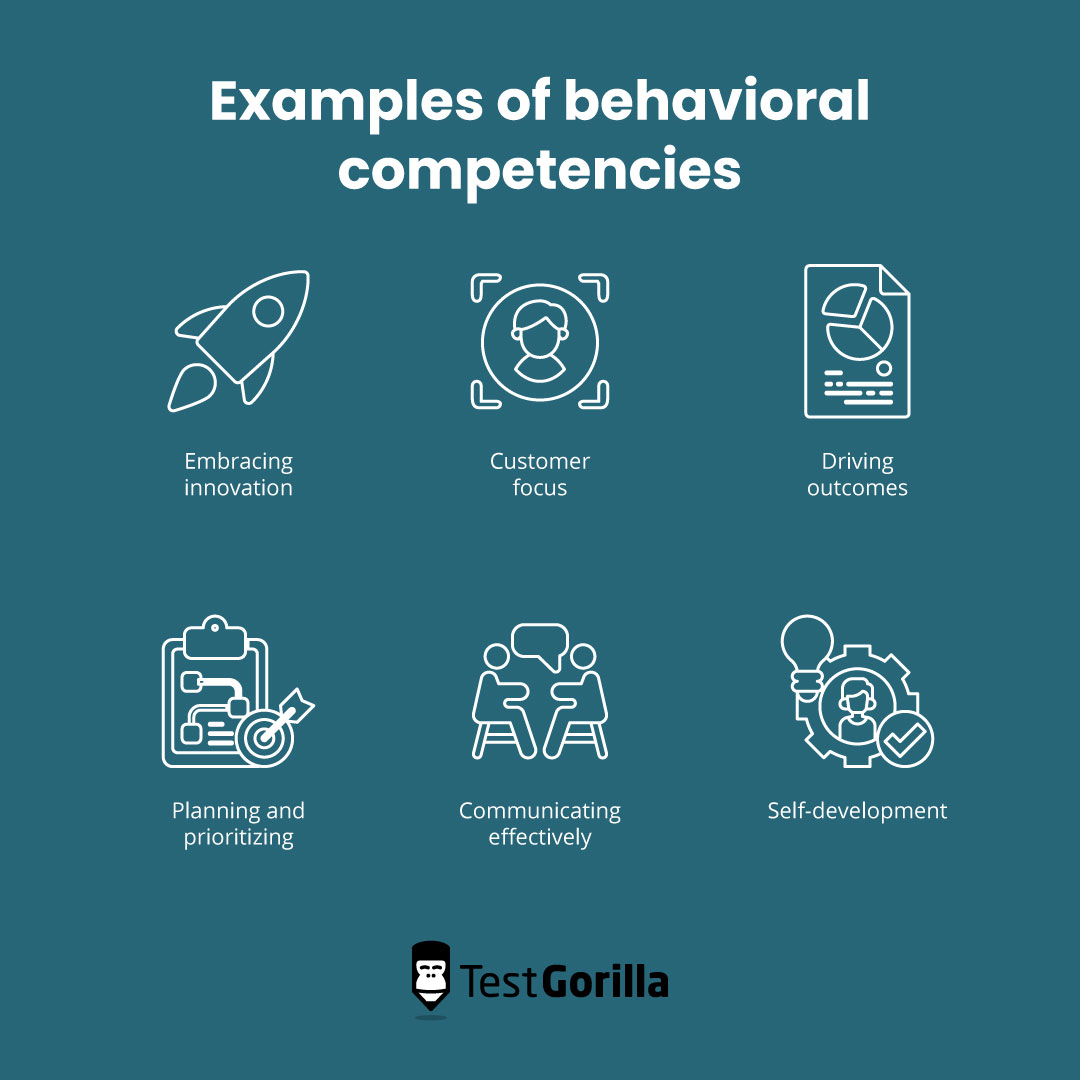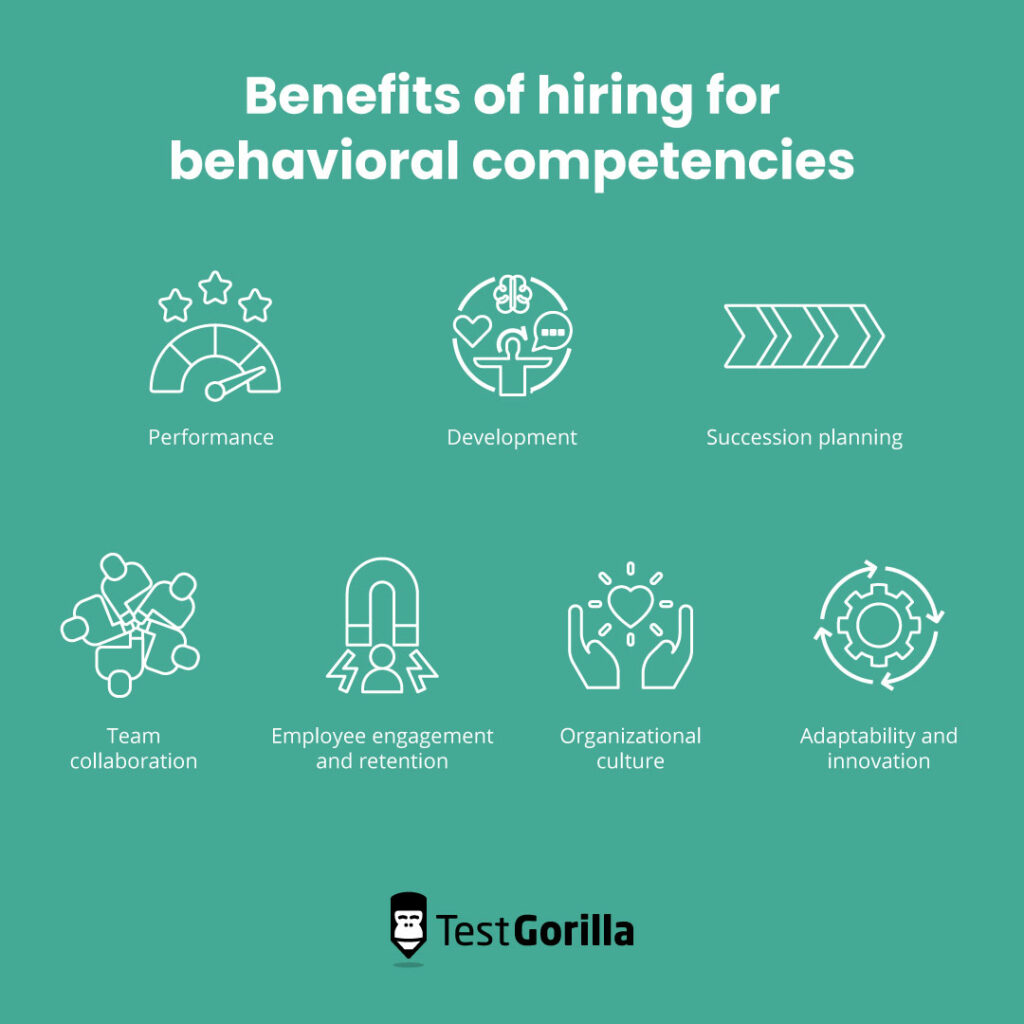A brief introduction to: Behavioral competencies
Science series materials are brought to you by TestGorilla’s team of assessment experts: A group of IO psychology, data science, psychometricians, and IP development specialists with a deep understanding of the science behind skills-based hiring.
Over the past months, we have been hard at work experimenting with the best way to integrate comprehensive behavioral competencies into our talent assessment software.
Read on to find out why we embarked on this initiative, what exciting offerings we have planned, and what that means for you.
What are the critical factors that separate average employees from the most successful hires? A growing body of evidence shows that a collection of behaviors known as behavioral competencies could be key to predicting workplace effectiveness and future career success at a time when jobs are becoming increasingly complex.
Table of contents
- What are behavioral competencies?
- What is a behavioral competency framework?
- Why are behavioral competencies important?
- 7 benefits of hiring for behavioral competencies
- How are behavioral competencies assessed?
- The science behind behavioral competencies at TestGorilla
- Stay tuned for the first glimpse of our new behavioral competency framework
- Learn more about the research that drives TestGorilla
What are behavioral competencies?
At TestGorilla, we define behavioral competencies as observable and measurable behaviors and skills that are required to perform effectively in a job function or role.
Importantly, behavioral competencies typically focus on soft skills or universal skills that are transferable across different roles, organizations, and industries rather than specific technical expertise (“hard skills”).
Examples of behavioral competencies include:
Embracing innovation
Being customer-focused
Being results-driven
Planning and prioritization
Communicating effectively
A focus on continuous self-development
Once properly identified and categorized, these attributes can be used to develop a comprehensive competency framework.
What is a behavioral competency framework?
A competency framework (also called a competency model, competency dictionary, or competency library) consists of behavioral competencies that have been combined in a logical structure with defined relationships between them.
Due to the broad appeal and general applicability of the framework, it can be used to define and evaluate successful performance for a vast number of jobs and roles across different functions, organizations, and industries.
Why are behavioral competencies important?
Behavioral competencies can help organizations facilitate end-to-end talent management practices, from identifying job-relevant competencies as part of job analysis, to selecting the right tests for candidate evaluation, to conducting structured interviews, to managing employee development, internal mobility, and performance. As such, they form the basis for a variety of critical HR interventions.
Overall, behavioral competencies are instrumental in driving individual, team and organizational success by shaping organizational culture, promoting collaboration, fostering engagement, and ensuring talent is aligned with organizational values and objectives.
7 benefits of hiring for behavioral competencies
1. Performance
Behavioral competencies directly impact individual and team performance. They define the skills, behaviors, and attributes needed to excel in a specific role or function.
During job analysis, these attributes should be highlighted and (along with technical skills and other requirements) used to create a job description. Behavioral competencies can then be evaluated across all phases of recruitment with targeted assessments, structured interviews, and work assignments.
By aligning competencies with job requirements in this way, organizations significantly improve their chances of hiring an employee that is productive, efficient, and motivated to perform in their new role.
2. Development
Although behavioral competencies consist of underlying stable attributes (e.g., personality) and more malleable dispositions (e.g., numerical ability), they can be learned and developed.
To facilitate these outcomes, organizations can use assessments to benchmark current competency levels for employees across different teams and roles and to conduct talent audits to evaluate the current and future skills and capabilities needed to drive the organization’s strategy and objectives. Customized learning and development strategies can then be formulated, with targets set based on each individual’s results.
During performance evaluations, employees should ideally be evaluated using 180 or 360 degree evaluations on the behavioral competencies that have been identified as important for the role.
3. Succession planning
Behavioral competencies play a crucial role in identifying and developing future leaders. They help organizations identify high-potential employees who possess the critical skills and behaviors for leadership roles. By assessing and developing these competencies, organizations can cultivate their talent pipeline and ensure continuity in leadership positions.
The best way to support this process is by developing a multi-level framework that provides guidance on the types of competencies expected at different levels of seniority. Employees can use this model to understand the areas of development they should focus on and possible adjacent skills they could develop based on their current competencies.
4. Team collaboration
Behavioral competencies foster collaboration and teamwork within organizations. They emphasize skills like communication, empathy, and conflict resolution, which are essential for building strong working relationships. By selecting individuals that excel in these areas, organizations can create a positive and cooperative work environment.
5. Employee engagement and retention
Behavioral competencies contribute to employee satisfaction, engagement, and retention. When employees feel their competencies are recognized and valued, they are more likely to be motivated and committed to their work. Moreover, competencies that promote professional growth and development can enhance job satisfaction and loyalty.
6. Organizational culture
Behavioral competencies shape the culture of an organization. They define the desired values, behaviors, and norms that guide employee interactions and decision-making. By promoting and selecting for behavioral competencies that add to the desired culture, organizations can cultivate a positive and inclusive work environment.
7. Adaptability and innovation
Behavioral competencies related to adaptability, creativity, and innovation are critical in today’s volatile world of work, where uncertainty and ambiguity are everpresent. To navigate these challenges, employees must be able to understand the different factors at play in their industry, embrace change, think critically, and generate new ideas.
By fostering these competencies, organizations can stay agile and competitive.
How are behavioral competencies assessed?
There are many different types of tests and measurement methods that can be used to assess behavioral competencies during selection, including:
Competency-based interviews: These are structured interviews in which open-ended questions and statements are used to evaluate the candidate’s job-related behavioral competencies.
Self-report questionnaires: The candidate is asked to complete a highly structured survey about their attitudes, skills, and capabilities.
Situational judgment tests: These tests measure the behaviors and skills a candidate employs in response to various work-related scenarios.
Assessment center exercises: A variety of interactive tests that are designed to assess a candidate’s behavioral competencies.
Simulations and work samples: Candidates are put into realistic work scenarios and asked to perform the type of duties involved in the role.
TestGorilla will assess behavioral competencies by means of differentiated tests that balance innovation and a best practice approach.
The science behind behavioral competencies at TestGorilla
With nearly 50 years of combined experience in behavioral competency use, development, and assessment, our team of industrial/organizational psychologists has developed a new behavioral competency framework that is relevant for most job roles, organizational contexts, and industries.
This framework defines observable behaviors for almost every role covered in our test library, enabling users to include the assessment of behavioral competencies into their multi-measure assessments with ease.
The resulting framework:
a) Fits perfectly with our philosophy of skills-based hiring
b) Complements existing tests for personality, cognitive ability, and technical skills
c) Is modern, future-oriented, and in keeping with the new future of work economy
Stay tuned for the first glimpse of our new behavioral competency framework
We’ll soon be launching our first test that assesses six critical behavioral competencies within our framework. This test will cover six intrapersonal (self-management) competencies, including self-awareness, self-development, resilience, navigating ambiguity, earning trust, and being bold.
As we continue to think about the core behaviors driving successful job performance in the new world of work, we’ll continue to innovate and iterate on our offerings in this area and extend coverage for these tests to encompass the entirety of our behavioral competency framework.
Ultimately, we aim to provide hiring managers with a comprehensive and flexible behavioral competency test that enables them to evaluate the behavioral competencies that are critical to driving success in their organization.
Regardless of the industry, organizational context, job function, job family, job level, or role, our users will be able to apply this test to support their search for the best talent possible.
Learn more about the research that drives TestGorilla
Want to know more about the science behind TestGorilla? Here are some more great articles from our science series:
Related posts
You've scrolled this far
Why not try TestGorilla for free, and see what happens when you put skills first.
Latest posts
The best advice on pre-employment testing, in your inbox.
No spam. Unsubscribe at any time.

Hire the best. No bias. No stress.
Our screening tests identify the best candidates and make your hiring decisions faster, easier, and bias-free.
Free resources
This checklist covers key features you should look for when choosing a skills testing platform
This resource will help you develop an onboarding checklist for new hires.
How to assess your candidates' attention to detail.
Learn how to get human resources certified through HRCI or SHRM.
Learn how you can improve the level of talent at your company.
Learn how CapitalT reduced hiring bias with online skills assessments.
Learn how to make the resume process more efficient and more effective.
Improve your hiring strategy with these 7 critical recruitment metrics.
Learn how Sukhi decreased time spent reviewing resumes by 83%!
Hire more efficiently with these hacks that 99% of recruiters aren't using.
Make a business case for diversity and inclusion initiatives with this data.



















